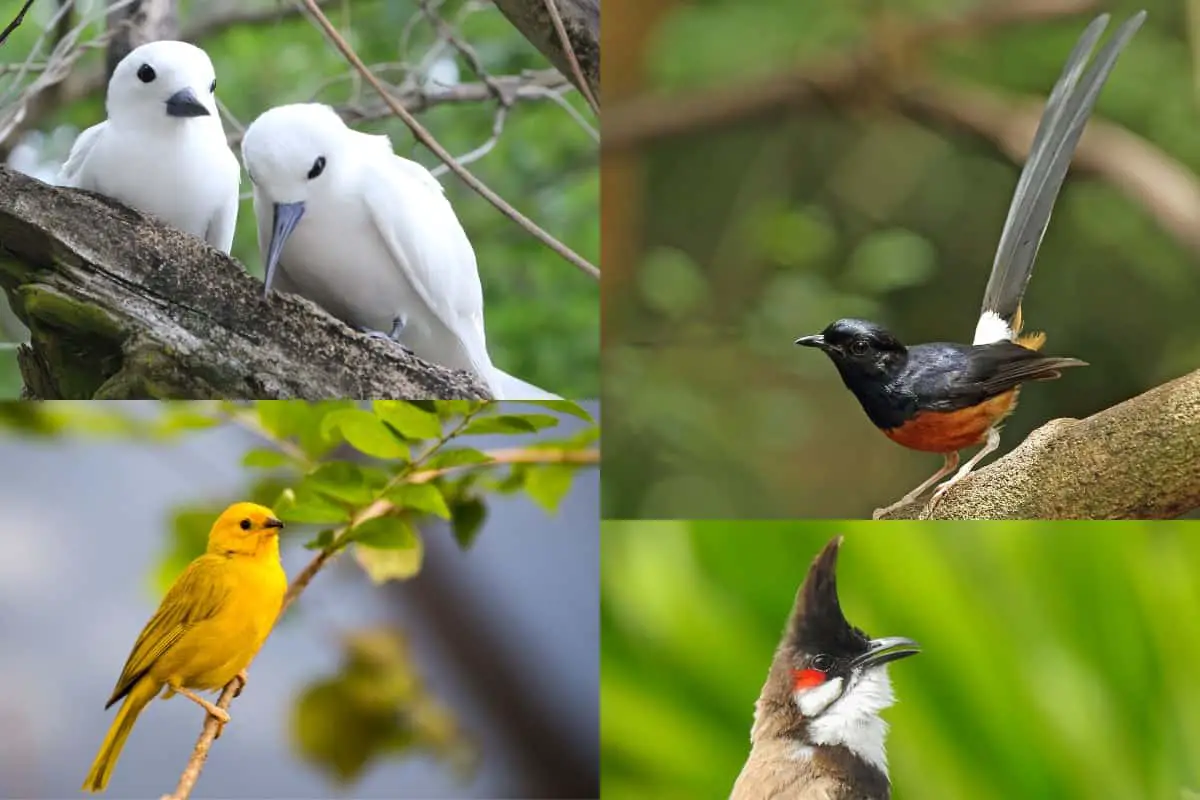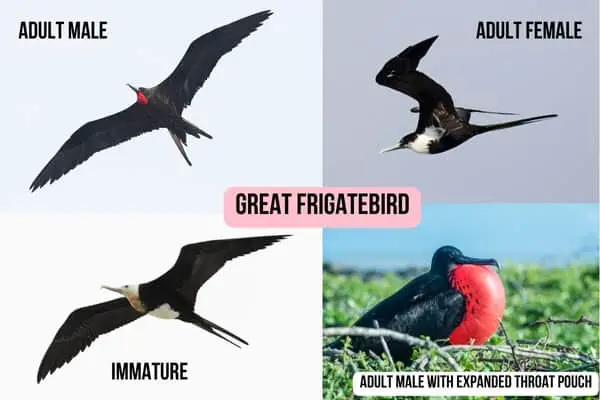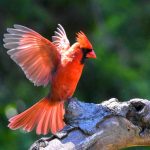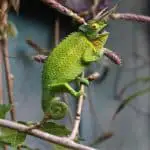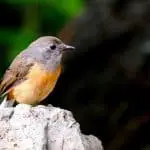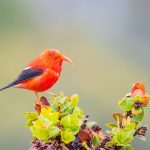Hawaii is a stellar place to live or visit. Whether you’re an enthusiastic birdwatcher or curious tourist, this list will provide you with information to help you identify some of the common birds in O’ahu. We’ve put together a list of 33 species you may run into while visiting the beach, a state park, driving through the countryside or just hanging out at a resort.
33 Birds in O’ahu
Let’s dive in to 33 species found around the island of O’ahu, with incredible diversity from all around the world!
1. Zebra Dove
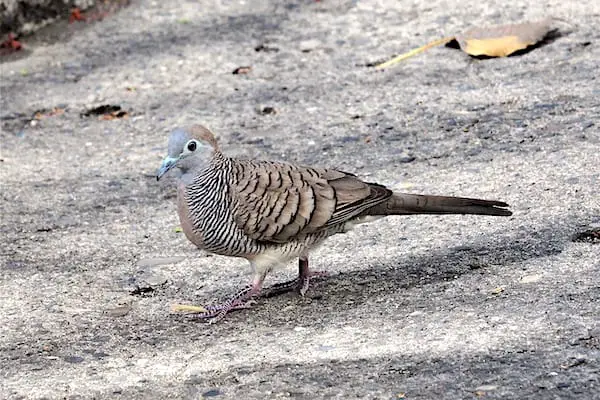
- Scientific name: Geopelia striata
- Other names: Barred Ground Dove
- Native: No
The Zebra Dove, also known as the Barred Ground Dove, is a small bird that is native to Southeast Asia. Their feathers are a mix of brown, gray, and black, with distinctive black and white stripes on their neck and breast. They have pink legs, and pale blue skin around their eyes. Their call is a series of rapid “coos”, and they are often found in pairs or small groups.
The zebra dove is primarily a seed-eating bird, but they also consume insects and small invertebrates. They are known to forage on the ground, searching for food among grasses and leaves. They are also attracted to bird feeders and will readily consume seeds that are provided for them. In Hawaii, the zebra dove is a common sight in urban and suburban areas, where they feed on grass seeds and insects that are found in gardens and parks.
Zebra doves are monogamous and form long-term pair bonds. They build their nests on the ground, often in grassy areas or under shrubs. The female typically lays two eggs, which are incubated by both parents. Once the chicks hatch, they are fed by both parents until they are able to fend for themselves.
Zebra doves were introduced to Hawaii in the 1920’s and spread quickly across the islands. They are known for being rather tame, and frequenting outdoor eating establishments. Watch out for these guys if you are at an outdoor restaurant, some are so bold they will land on tables and chairs!
2. Short-eared Owl (Hawaiian)
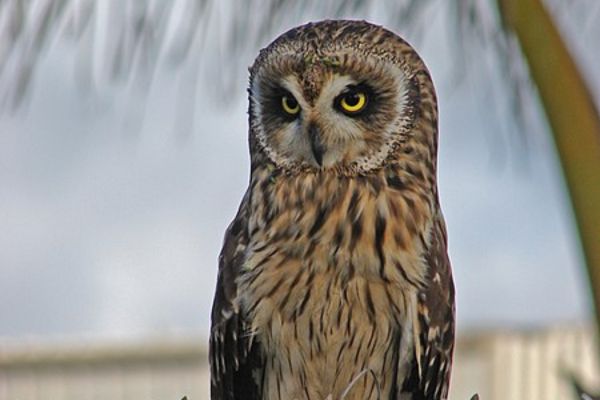
- Scientific name: Asio flammeus sandwichensis
- Other names: Pueo
- Native: Yes
Pueos are the only native predatory bird on the island of O’ahu. While the short-eared owl can be found in many places, this is a subspecies only found on the Hawaiian Islands. Often referred to as Pueo, these owls actually hunt during the day in open pastureland and forests.
The Hawaiian Short-eared Owl has mottled brown and white plumage, with large, bright yellow eyes and short, feathered ear tufts. Their ear tufts are generally hard to see, so their head just appears round with dark patches around the eyes and a pale face.
You’ll likely see them perched on fenceposts or dead trees, or flying low over open fields. Although they are considered native to the islands, they did not live on the islands before people arrived. These owls eat mainly rodents, and before humans Hawaii’s only land mammals were bats, so they didn’t have a good enough food source. It is believed they only became a permanent resident to the islands after Polynesian rats arrived with Hawaii’s first settlers.
The Pueo is an important part of Hawaiian culture and mythology, and is considered a sacred bird by many Native Hawaiians. They are looked at as ‘aumakua, family guardian spirits. Unfortunately their numbers are declining due to factors including habitat loss, light pollution, and introduced mammals like the Indian mongoose that eat their eggs and young.
On O’ahu they are considered an endangered species. James Campbell National Wildlife Refuge is a good place to try and spot one.
3. Warbling White-Eye

- Scientific name: Zosterops japonicus
- Other names: Japanese White-eye, Mejiro
- Native: No
The Warbling White-eye is a small songbird that is native to Japan, Taiwan, and the Philippines. Their feathers are a mix of green, yellow, and white, with a distinctive white ring around their eyes. The Warbling White-eye has a small, pointed beak that is ideal for probing flowers and fruit. They have a melodious song that is often heard in the forests and gardens of Hawaii.
Warbling white-eyes are primarily a nectar and fruit-eating bird, but they also consume insects and small invertebrates. They are also attracted to bird feeders and will readily consume sugar water that is provided for them.
Warbling white-eyes were introduced to O’ahu in 1929 and quickly spread to all the islands. They have been so successful, that they have been considered Hawaii’s most abundant land bird since the late 1980’s. Unfortunately they have been identified as a vector for avian parasites that adversely affect native Hawaiian birds like honeycreepers.
Look for them among leaves and flowers in gardens, parks and forests.
4. Common Gallinule (Hawaiian)

via Flickr
- Scientific name: Gallinula galeata sandvicensis
- Other names: Hawaiian moorhen, ‘Alae ‘ula
- Native: Yes
The Common Gallinule is a common water bird in North and South America. There are several subspecies, with one endemic to the Hawaiian Islands. Locally called ‘Alae ‘ula, this gallinule has a chicken-like body on thin legs, with extra large feet and toes. Their dark body is highlighted by a red forehead shield and beak tipped in yellow. Their legs are yellow with an orange band at the very top.
The Hawaiian gallinule is dependent on freshwater wetland habitats with dense emergent vegetation for nesting. Their large feet help them balance on lily pads and floating vegetation. They swim or walk through shallow water, looking for plants, seeds, snails, insects and small fish. While marshes and freshwater swamps are their favorite environment to hang out in, they will also reside in agricultural zones and irrigation ditches.
Most populations of this bird can be found on Kaua’i and O’ahu. On O’ahu they are found throughout the island with most in the Hale’iwa and Waimanalo areas. They are also seen at Pearl Harbor.
5. Hawaiian Coot
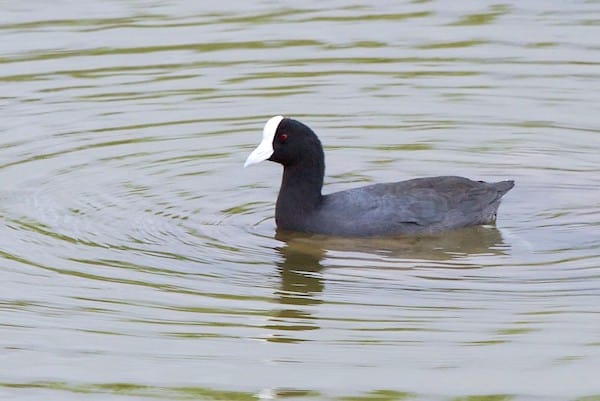
- Scientific name: Fulicia alai
- Other names: Hawaiian coot, ‘alae k’oke’o
- Native: Yes
Known as ‘alae ke’oke’o in Hawaiian, this coot species in only found on Hawaii. With their dark body, white beak and white forehead shield, they look very similar to the American coot, but the frontal shield on the Hawaiian coot is much larger and more rounded. It can appear all white or dark red.
You may notice they look similar to the Hawaiian gallinule, and they are often found in the same places. Find these coots in wetlands, ponds, marshes, canals and in grassy areas adjacent to water such as lawns and golf courses. Coots have large, lobed toes that help them swim, but are better for walking on aquatic vegetation and land than fully webbed feet.
These generalists will eat vegetation, insects, and invertebrates. They often travel in groups where they forage for small tadpoles and fish.
The Hawaiian coot was listed as a federally endangered species in 1970. Ponds at golf courses and resorts are good places to spot them. Or look for them at the Ho’omaluhia Botanical Garden.
6. Java Sparrow
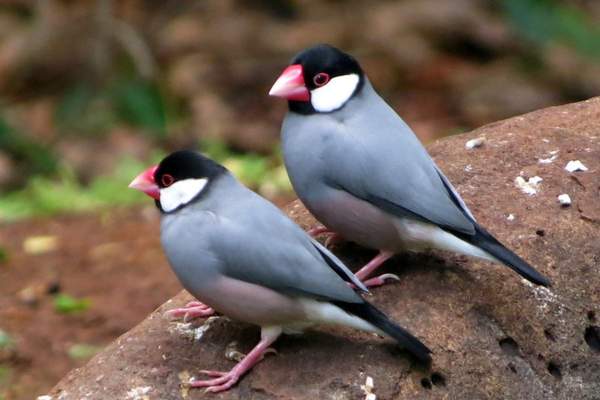
- Scientific name: Padda oryzivora
- Other names: Java Finch
- Native: No
The java sparrow is a small bird that is native to Indonesia. They have since been introduced to many parts of the world, including Hawaii where they were they have spread from O’ahu in the 1960’s to most of the main islands. These social birds are often found in pairs or small flocks.
These large finches are easy to identify due to their unique coloration. They have gray bodies with rosy bellies, a black head, bright white cheek patches, a red eye and thick pink beak.
Java sparrows are primarily seed-eating birds, and can be considered pests in rice fields and other agriculture due to their appetite. In fact, they used to be a common exotic pet bird in the continental United States until their importation was banned due to escaped birds potential threat to agriculture.
In Hawaii, the java sparrow is a common sight in urban areas and gardens. They are more populous in the southern half of O’ahu.
7. House Sparrow

- Scientific name: Passer domesticus
- Other names: none
- Native: No
The house sparrow is a small bird that is native to Europe, Asia, and North Africa. They have since been introduced to many parts of the world, including Hawaii. Both sexes have a mix of brown, gray, and black feathers. The male has a distinctive black bib on its throat, and rufous patch at the nape of the neck, while the female has a plain brown head.
House sparrows are primarily seed-eating birds, but they also consume insects and small invertebrates. They are known to forage on the ground, usually in a group, using their beaks to search for food among the grass and leaves. A common sight in urban and suburban areas, they are very at-home with man-made structures. You may see them nesting in storefront signs or other nooks and crannies of buildings.
They love to search for human food in high-traffic areas like beaches, outdoor restaurants and cafes. Don’t walk away from your plate if eating outside, or you might come back to find a House Sparrow sharing your meal!
House sparrows are social birds and are often found in large flocks. They are also known for their aggressive behavior towards other birds, often competing with native species for food and nesting sites.
8. Black-necked Stilt
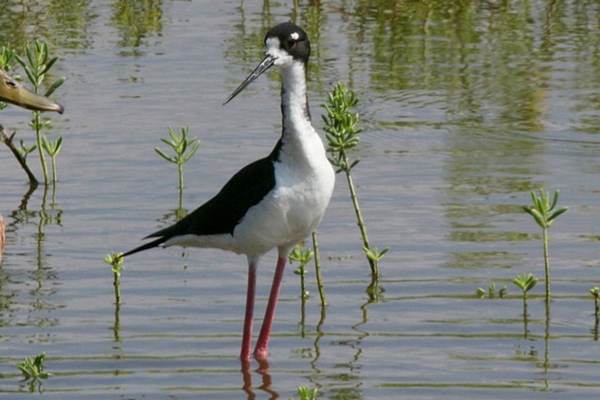
- Scientific name: Himantopus mexicanus knudensi
- Other names: Hawaiian Stilt, Ae’o
- Native: Yes
Black-necked Stilts are medium-sized wading birds native to North and South America. The black-necked stilt has quite a distinctive look, with its black and white plumage, long pink legs and long thin bill. The black-necked Stilts that live in Hawaii are often considered their own subspecies, the Hawaiian black-necked Silt or Ae’o.
They use their long, stilt-like legs to wade in shallow water while probing the mud with their beak for food. Insects, crabs, worms, and fish are all on the menu, so you’ll find them foraging in shallow water bodies. In proportion to their body size, they have the second-longest legs of any bird species.
Most of the Hawaiian stilts live on Maui, O’ahu and Kaua’i. While the North and South American populations are fine, the Hawaiian stilt is considered endangered. Loss of wetland habitat and introduced mammal predators like cats, dogs and mongoose are some of the main causes.
The Lochs around Pearl Harbor, Ka’elepulu Pond and Kailua Beach Park are some spots to look for them.
9. O’ahu ‘elepaio
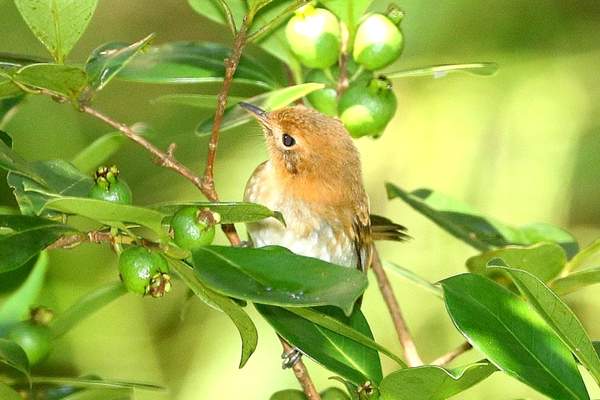
- Scientific name: Chasiempis ibidis
- Other names: –
- Native: Yes
Only the island of Oahu is home to the O’ahu ‘elepaio, a small flycatcher that lives in the lowland forests of the Ko’olau and Wai’anae Ranges. These ranges max out at 2,775 in elevation, which is comparatively low elevation compared to the 9,000 foot peaks on the island.
Males and females have a dark brown upper body and a white lower body with light brown streaks on the breast. They also have white wing bars, tail feather tips, and throat. Both genders may have varying amounts of black markings, but males typically have more of these markings than females.
A mated pair makes cleverly concealed nest cups, decorated with lichen and moss for camouflage. Both sexes work together to rear the young. Their diet contains a lot of insects, which they catch on the wing or pluck from plants, rocks and trees while actively foraging.
Predation by black rats is one of the biggest threats facing these birds. Rats prey on both the adults, juveniles, and young in the nest.
10. ‘Apapane

- Scientific name: Himatione sanguinea
- Other names: –
- Native: Yes
The Apapane is the most abundant honeycreeper in Hawaii and is found on most of the main islands, including O’ahu. They may be the most populous native Hawaiian bird. Adults are red with black on their wings and tail, and a white patch below the tail. They have black legs and a black, slightly down-curved beak. Juveniles are brownish yellow.
Apapanes are primarily nectar-eating birds, but they also consume insects and spiders. They forage in the canopy of trees, using their beaks to sip nectar from the flowers of native plants. Often found in flocks feeding on ‘ohi’a trees. They have a long history of association with Hawaiian culture. They have been used in Hawaiian chants and songs, and are considered a symbol of love and loyalty.
The Apapane is also an important species in the ecosystem of Hawaii. They are important pollinators of native plants, and their presence is an indicator of the health of the forest ecosystem. Despite their importance, the Apapane is threatened by habitat loss and the introduction of non-native species.
To find these birds you’ll need to head for more forested areas with flowering trees. Especially areas with ‘Ohi’a lehua, the most common native Hawaiian tree. Try the ‘Aiea Ridge Trail, or Manoa Cliffs Trail.
11. Common Myna
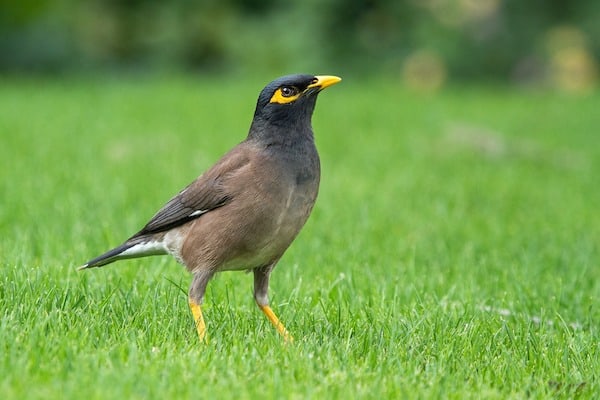
- Scientific name: Acridotheres tristis
- Other names: Indian Myna, Indian Mynah
- Native: No
The Common Myna is a member of the starling family. Both males and females have yellow bills, legs, and skin around the eyes. They have a brown body, black head, and large white wing patches visible when they fly.
They aren’t particularly shy of humans, so they are one of the most often spotted birds on O’ahu since they hang out around human developed areas like the airport, hotels, beaches and parks. Common mynas are omnivorous birds that eat pretty much anything they can find, including insects, arachnids, crustaceans, reptiles, seeds, grain, and fruits. They will also probably be interested in any food you happen to drop on the ground.
In the evening, large groups of common mynas gather in communal roosts in large trees. They are very “chatty” birds and can be quite noisy when they all get together.
In Hawaii, common mynas are considered an invasive species and are known to displace native birds and deplete their food supply. They were introduced from India in the 1850’s to help control insect pests like army worms. Unfortunately their territorial behavior has led to some negative impacts on the ecosystem.
12. White-rumped Shama
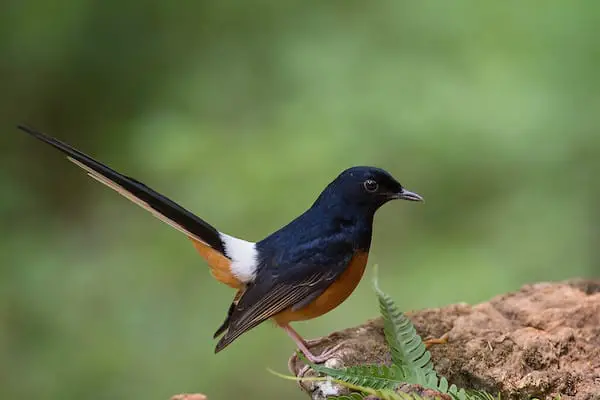
- Scientific name: Copsychus malabaricus
- Other names: Shama Thrush
- Native: No
The white-rumped shama is a small, pretty bird common on O’ahu. Males have a black head, back, and wings, with a bright chestnut belly and a distinctive white patch on its rump. Females have slightly shorter tails and more of a brownish-gray than black.
This bird is native to Southeast Asia, but was introduced to Hawaii in the 1930s and 40s, where it has established populations on the islands of O’ahu, Kaua’i, and Hawaii. It prefers forested areas with dense vegetation and a mix of open space and cover. Look for them in forested areas, parks, and gardens, and is often seen near streams and other bodies of water.
These shamas are known for their melodious and varied song. Their pretty singing makes them popular as caged pets in South Asia. They sing a variety of phrases and include mimics of other birds. They are active birds, often seen hopping and flitting through the forest understory, or foraging on the ground for insects and small invertebrates.
13. Black-crowned Night-Heron
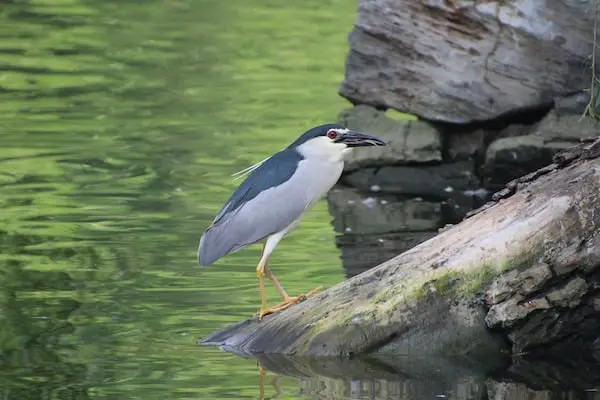
- Scientific name: Nycticorax nycticorax
- Other names: ‘Auku’u
- Native: yes
The Black-crowned night-heron is a medium-sized wading bird that is native to several continents, and is considered a native species in Hawaii. Locally they are called ‘auku’u. Unlike many herons with long legs and necks, the black-crowned night-heron has a squat shape with shorter legs. They have a gray body, with a black crown and back, and red eyes. During the breeding season, a few long white feathers stream from the back of their head. Juveniles are brown and spotted.
They hunt for fish, shellfish, frogs, lizards, mice, insects and even smaller birds. Find them near ponds, marshes, streams and shoreline, remaining still while watching for prey then striking out with their sharp beak.
Black-crowned night-herons are a solitary bird and are often seen alone or in small groups. They build their nests in trees or shrubs.
14. Spotted Dove

- Scientific name: Spilopelia chinensis
- Other names: Indian Turtle Dove
- Native: no
The Spotted Dove is a small bird that is native to Asia and brought to Hawaii in the 1800s. They have an overall soft, rosy coloring with brown wings and a distinctive black patch on their upper back covered in white dots.
Spotted doves are primarily seed-eating birds, but they also consume insects and small invertebrates. They forage on the ground in open fields, parks, forests and gardens. They are fairly tame and comfortable in urban and suburban settings, so you’re likely to run into one on any of the islands.
Spotted doves are monogamous and form long-term pair bonds. In Hawaii they breed year-round, building their nests in trees or shrubs, using grass, twigs, and other materials to create a sturdy structure. As part of courtship, males will bow, coo, and make aerial displays.
15. Black-footed Albatross
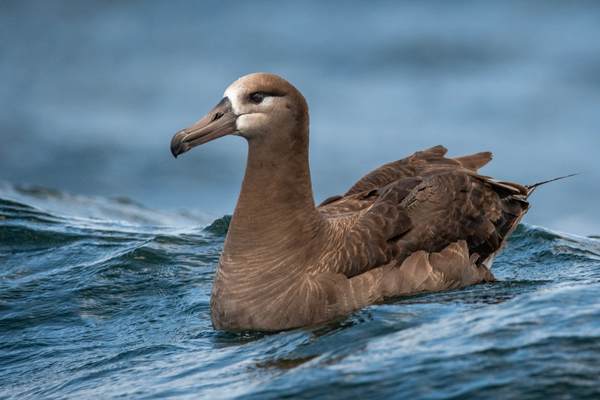
- Scientific name: Phoebastria nigripes
- Other names: Ka’upu
- Native: Yes
Albatrosses are some of the longest lived birds on earth, and the black-footed albatross is no exception. So named for its black feet, this seabird has almost entirely dark feathers. The only white is a white stripe before the bill and around the eyes.
With a wingspan of about six feet, these large birds glide and soar in ways that save energy so they can cover hundreds of miles over the ocean in flight. They feed on fish, squid and crustaceans.
Breeding colonies for albatrosses can contain hundreds of nesting pairs. Mated pairs often mate for life. Every year, they’ll conduct elaborate mating dances and rituals. The black-footed albatross can be seen at sea around the northern Hawaiian Island (mainly O’ahu and Kaua’i) from November to May, which is their breeding season. Look for them a Ka’ena Point NAR and the shore along the northern tip of the island.
16. Wandering Tattler

- Scientific name: Tringa incana
- Other names: ‘Ūlili
- Native: Yes, Migratory
This medium-sized shorebird is a migratory species that breeds in the Arctic regions of North America and Asia. They spend their winters in the Pacific Islands, including Hawaii, as well as in coastal regions of North and South America. During their migration, they can be found in a variety of habitats, including rocky shorelines, tidal pools, and estuaries.
During the breeding season, the wandering tattler has a mottled brown and white plumage, with a distinct white eyebrow stripe and a dark patch on the back of the neck. However in Hawaii you’ll mostly see their non-breeding plumage, when it changes to a more uniform gray-brown coloration. The white eyebrow stripe is still present, but the dark patch on the back of the neck is less distinct.
Wandering tattlers are primarily insect-eating birds, but they also consume small crustaceans, mollusks, and fish. You’ll see them alone or in small groups, foraging in shallow water, using their long legs to wade and their beaks to probe the mud for food. They are also attracted to rocky shorelines and tide pools, so look for them along the coast from fall to early spring.
17. Great Frigatebird
- Scientific name: Fregata minor
- Other names: ‘Iwa
- Native: Yes, Migratory
Great frigatebirds are large seabirds (wingspans up to 7.5 feet) that are found in tropical and subtropical regions around the world, most commonly the Pacific and Indian Oceans. Therefore, they are considered native to the Hawaiian Islands. You’ll most likely notice frigatebirds soaring in the sky along the coasts. They have a distinctive shape, with long narrow wings and a deeply forked tail.
Male great frigatebirds have black plumage with a greenish sheen. They have red throat pouch that they can inflate during courtship displays, which makes them appear even larger and more impressive. Females also have dark plumage have a white breast, lighter beak and no throat pouch. Immature great frigatebirds look very similar to females, but they have a white head and more white on the belly.
Hawaiians call this bird ‘iwa, which means “thief”. This is in reference to a behavior they sometimes display where they will harass other flying seabirds until they drop their catch, then swoop down and steal it.
Great frigatebirds are primarily pelagic, meaning they spend most of their time at sea, but they also nest on islands and coastal cliffs. They build their nests out of sticks and other materials and lay a single egg per breeding season. These birds have a unique ability to fly for long periods of time without landing. They have been known to stay aloft for up to two months at a time, using air currents and thermals to stay in the air.
18. House Finch
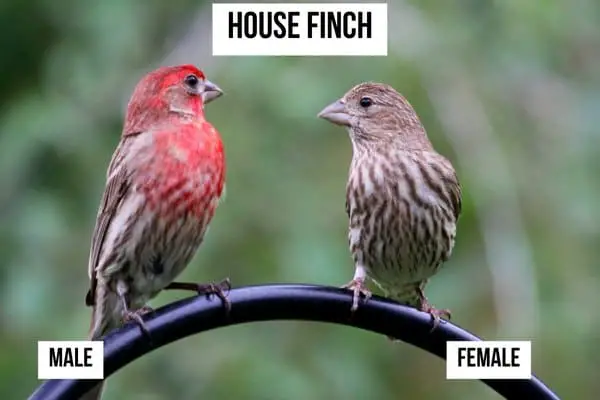
- Scientific name: Haemorhous mexicanus
- Other names: Papaya birds
- Native: No
The house finch is a small songbird that is native to North America. Both males and females are heavily streaked with brown and cream, but males also sport a red wash on the head and chest. Interestingly, males can sometimes show orange and yellow coloring instead of red, and this is more commonly seen in Hawaii than on the mainland.
The red coloring in their feathers come from carotenoid pigments in the foods they eat while they are going through the molting process. In Hawaii, house finches really enjoy eating the tropical fruit papaya. So much so, that some locals call them “papaya birds”. Papaya doesn’t have enough carotenoids to produce dark red feathers, so House Finches that consume a lot of papaya tend to be more orange or yellow.
They were introduced to Hawaii in the mid 1800’s and are now common on all the main islands. House Finches mainly eat seeds, grains and berries. They are known to forage on or in vegetation, and readily visit bird feeders. They like mixed seeds, sunflower or like many finches, thistle seed. House Finches are a social bird and are often found in flocks, especially during the winter months.
19. Yellow-fronted Canary
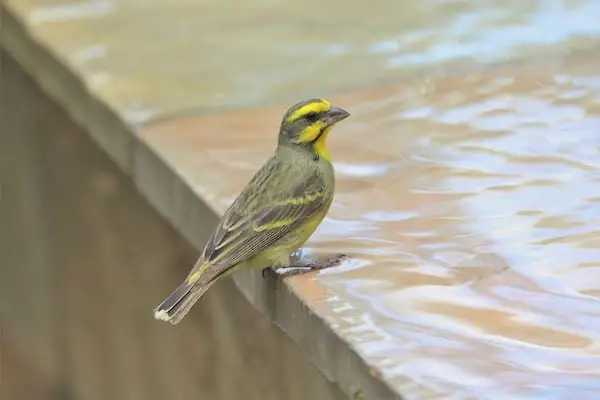
- Scientific name: Crithagra mozambica
- Other names: Yellow-eyed Canary, Green Singing Finch
- Native: No
The yellow-fronted canary is a small, Africa-native bird that belongs to the Finch family. These birds are popular among pet owners for their beautiful plumage and their delightful singing. According to Hawaii.gov, they were brought to the islands in the 1960’s and have established wild populations on O’ahu and the Big Island.
Yellow-fronted canaries have an olive colored body and head, with a yellow breast and yellow wingbars. Their most striking feature is their face, with a bright yellow stripe above and below their eye. Males and females look alike, but males have a slightly brighter yellow forehead. These birds have a small, conical beak that is adapted for cracking seeds, their primary food source.
In the wild, yellow-fronted canaries feed on a variety of seeds, including grasses, weeds, and flowers. They also eat insects and other small invertebrates, especially during the breeding season when they need extra protein to raise their chicks. In Hawaii, these birds are considered an agricultural pest because they feed on crops such as corn, sorghum, and rice. Despite their reputation as pests, yellow-fronted canaries are beloved by many people for their cheerful songs and vibrant colors.
20. Cattle Egret

- Scientific name: Bubulcus ibis
- Other names: n/a
- Native: No
The Cattle Egret is a medium-sized bird that is native to Africa and Asia, but can be found in many parts of the world today. Their feathers are mostly white, although you may see a buffy orange-brown patch on their head, breast, back and neck during breeding season. The cattle egret has a long, pointed beak that is yellow in adults and darker in juveniles. Their legs are yellow when breeding, and black when not.
Cattle egrets are primarily insect-eating birds. They are known to forage in fields and pastures, often following livestock such as cows and horses to catch insects that are disturbed by their movement. In fact, sometimes they will perch right on their back! In Hawaii, the cattle egret is a common sight in agricultural areas and grasslands. Unlike most egrets, they prefer to get their food in dry areas, but you’ll still see them near beaches and ponds throughout O’ahu.
Cattle egrets have been introduced to many regions to control insect populations in agricultural areas, and have even been used to control pests on golf courses. They were brought to Hawaii in the 1950’s and 60’s to help control cattle pests, and have thrived.
21. Rose-ringed Parakeet
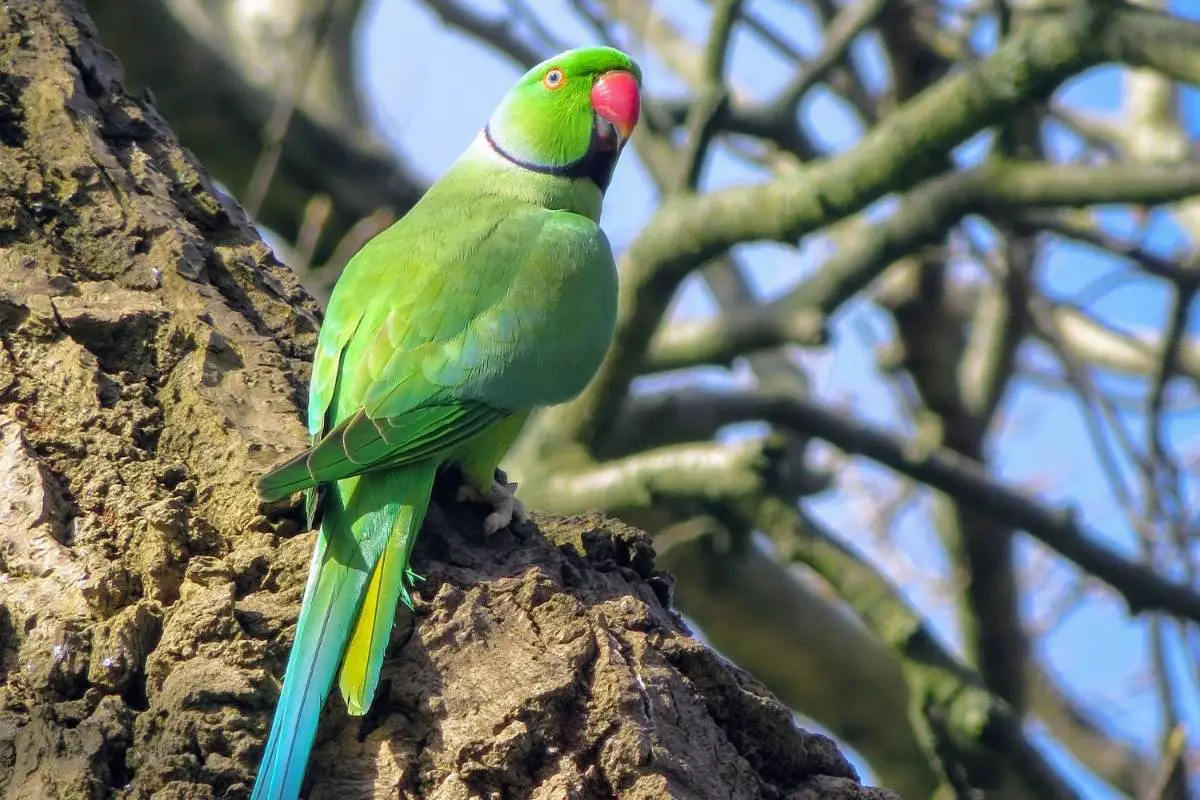
- Scientific name: Psittacula krameri
- Other names: n/a
- Native: No
Rose-ringed Parakeets are small to medium-sized parrots native to Africa and South Asia. Males and females have bright green plumage and a red beak, and males have a black and pink ring around their neck. They are popular as pets and are often bred in captivity for the pet trade. However, the rose-ringed parakeet has also established wild populations in many parts of the world, including Hawaii.
In Hawaii, the rose-ringed parakeet is considered an invasive species and, like many introduced birds and animals, is on “Hawaii Injurious Wildlife” list. It is believed that these birds were introduced to the islands in the 1960s as a result of the pet trade. Over time, they have established a large population on O’ahu, and smaller populations on Kaua’i, Maui, and the Big Island. The parakeets are known to cause damage to crops such as corn, sunflowers, and papayas, and they also compete with native birds for food and nesting sites.
Efforts are being made to control the population of rose-ringed parakeets in Hawaii. The state Department of Agriculture has implemented a trapping program to capture and remove the birds from areas where they are causing damage. In addition, some conservation groups are working to educate the public about the impact of invasive species on Hawaii’s native ecosystems. While the rose-ringed parakeet is a beautiful bird, its introduction to Hawaii is a reminder of the importance of responsible pet ownership and the need to protect native species from the impact of invasive species.
22. Red-crested Cardinal
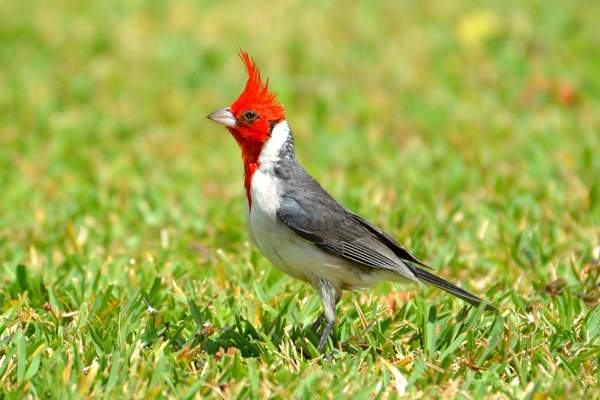
- Scientific name: Paroaria coronata
- Other names: n/a
- Native: No
The striking Red-crested Cardinal, is native to South America. Unlike the northern cardinal, all adults of this species have the same coloration. They sport a white underbelly, slate gray wings and back, and bright red chest and head with a tall crest. If you see a bird that looks just like this but with a brown head instead of red, that is a juvenile.
Despite its name and similar body shape, these birds are actually members of the tanager family and aren’t true cardinals.
Red-crested cardinals are primarily seed-eating birds, but they also consume insects and small invertebrates. On O’ahu, look for them in gardens and parks, especially beach parks. While they can be found inland, most sightings tend to occur along the coast.
23. Pacific Golden-Plover

- Scientific name: Pluvialis fulva
- Other names: Kolea
- Native: Yes, migratory
These plovers come to Hawaii to do what many of us would like to do, spend the winter. The Pacific Golden-Plover (locally called kolea), typically arrive in Hawaii in late August or early September, flying in from their breeding grounds in the Arctic tundra. During their migration, they fly non-stop for up to 88 hours, covering distances of up to 4,000 km.
For most of the winter their coloring will be a pale belly, with a back heavily mottled in brown, white and hints of gold. Find them on open lawns, golf courses and fields. At night they are known to roost in flocks, sometimes on hotel rooftops. They are also attracted to wetlands and mudflats, where they can find a variety of insects and invertebrates.
As spring approaches, they put on their “tuxedos”. Males sport solid black feathers on their face and belly, while females will also add black to those areas, but in patchwork instead of solid. Come April, they begin their migration back to their breeding grounds in the Arctic.
24. White-tailed Tropicbird
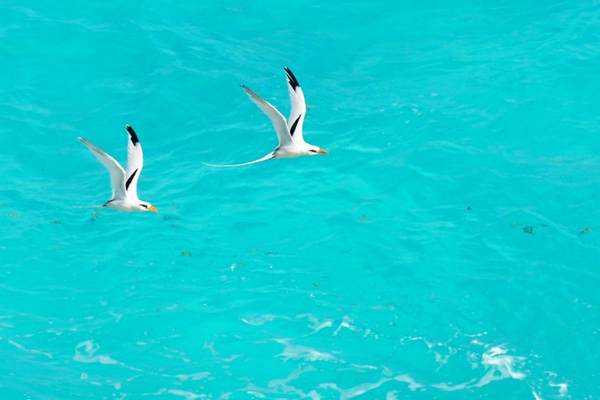
- Scientific name: Phaeton lepturus
- Other names: Koa’e Kea
- Native: Yes
The white-tailed tropicbird is a delicate seabird that lives in tropical and subtropical waters around the globe, including along the coasts of O’ahu and other Hawaiian islands. These beautiful white birds have streaks of black on their eye and wings, and a long, split tail that trails behind them.
This species of tropicbird breeds in the Hawaiian islands. They do nest mostly on other islands, but some are known to be in southeastern O’ahu. They prefer to breed and nest in crevices and along the walls of cliffs. It’s important that they be near the deep water because it helps the parents retrieve fish for the other parent and chicks.
This bird can dive directly into the water, surface with its catch, and fly off. The white-tailed tropicbird is a pelagic bird, meaning it spends most of its life at sea, only returning to land to breed. It feeds on small fish, squid, and other marine invertebrates, which it catches by diving into the water from high above. The bird is known for its graceful and acrobatic flight, which it uses to hunt for food and impress potential mates.
25. White Tern
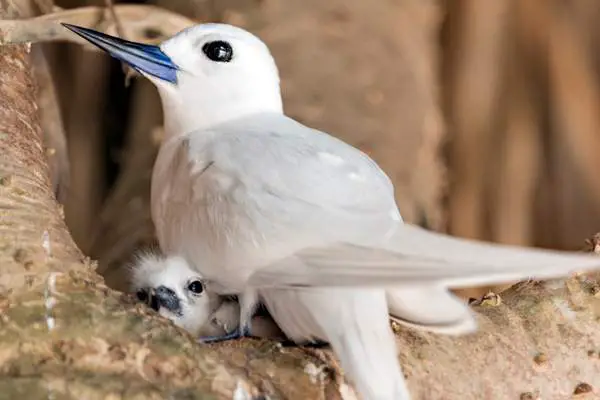
- Scientific name: Gygis alba
- Other names: Fairy Tern, Little Tern, Manu-o-Kū
- Native: Yes
The Manu-o-Kū is native to Hawaii, and it is believed that populations of the bird have been on the island for hundreds, if not thousands, of years. They aren’t as sociable as other species of terns. They like their independence and will nest in small groups, not huge colonies. One egg is laid in a depression on a tree branch, rock ledge or the ground, without any nest built.
These birds are solid white all over, with black feet, large dark eyes, and a black bill with blue at the base. The bird has a delicate, streamlined body that is designed for fast and agile flight, with long, pointed wings and a deeply forked tail that allow it to maneuver easily in the air. The main threats to these terns are rats and feral cats.
The white tern spends most of its life at sea, only returning to land to breed. Each day, they can travel up to 120 miles from their roosting spot to find food in the morning, and return in the late afternoon. The mainly eat small fish, squid, and other marine invertebrates caught by diving into the water from high above.
While found around all the islands, O’ahu is the only island that has a major population. They most often nest in trees in towns along the southern coast, so much so that in 2007 they were named Honolulu’s official “city bird”. Honolulu is also home to an annual Manu O Ku festival in May to teach the community about these beautiful birds.
26. Red-vented Bulbul
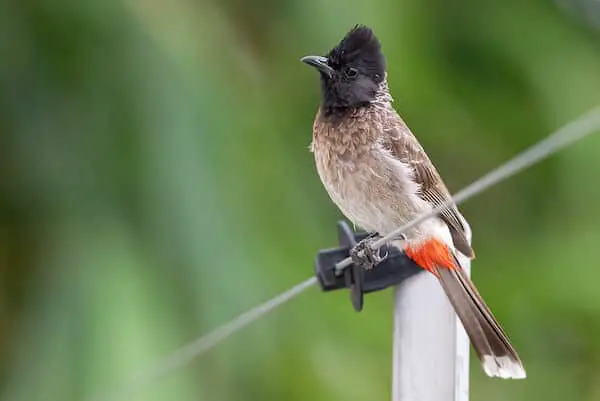
- Scientific name: Pycnonotus cafer
- Other names: n/a
- Native: No
The red-vented Bulbul is native to South Asia and Southeast Asia that has made its home on O’ahu. These cardinal-shaped birds have a distinctive black head and neck, with mostly brown body and a patch of red on the underside of their rump.
Illegally brought to Hawaii as pets, some were released into the wild on O’ahu in the 1950s and have established themselves on the island ever since. Most often seen in both urban and mountain areas perching on poles and wires. They do have a melodious song and can be quite gregarious, which is why they are often kept as pets.
In Hawaii, the red-vented Bulbul is known to cause damage to crops such as papaya, guava, and mango as well as orchids. They also compete with native birds for food and nesting sites, and is considered a threat to Hawaii’s delicate ecosystem. Sightings of this bird on any of the other islands are taken very seriously in an attempt to keep their population from growing. The state Department of Agriculture has implemented a trapping program to capture and remove the birds from areas where they are causing damage.
27. Red-whiskered Bulbul
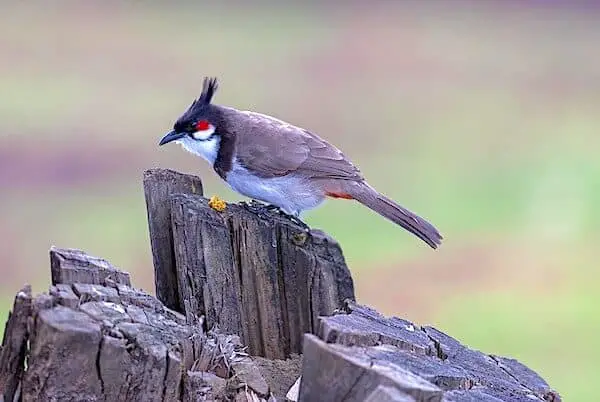
- Scientific name: Pycnonotus jocosus
- Other names: Crested Bulbul
- Native: No
A second bulbul species that is invasive in Hawaii is the red-whiskered bulbul. Just like their red-vented cousins, they were accidentally introduced around the 1960’s from Asia due to the pet trade, and are most populous on O’ahu. They create the same problems, displacing native birds and damaging fruit crops.
They are, however, quite lovely looking birds. They have a gray body with a white belly and red patch on the underside of their tail. Their face has a unique appearance with a black head and crest, red cheek-patch, white throat and black chest band. Red-whiskered bulbuls often congregate together in small groups, enjoying forest, garden and orchard habitats.
28. Common Waxbill

- Scientific name: Estrilda astrild
- Other names: St Helena Waxbill
- Native: No
The cute common waxbill is native to sub-Saharan Africa, and was first reported in Hawaii around the 1970’s. They have been spotted on most of the islands, but are quite populous on O’ahu.
The common waxbill is a small bird, measuring about 4 inches in length. They have a distinctive orange-red bill and a red patch over their eyes. Their body is gray-brown and very finely barred.
In Hawaii, the common waxbill feeds on seeds, insects, and small invertebrates. The bird is known for its acrobatic feeding behavior, often hanging upside down from branches to reach its food. Look for them in urban and suburban areas, as well as agricultural areas. You’ll often see them foraging in the grass and tall weeds. These social birds often gather together in large, mixed flocks.
29. Scaly-breasted Munia
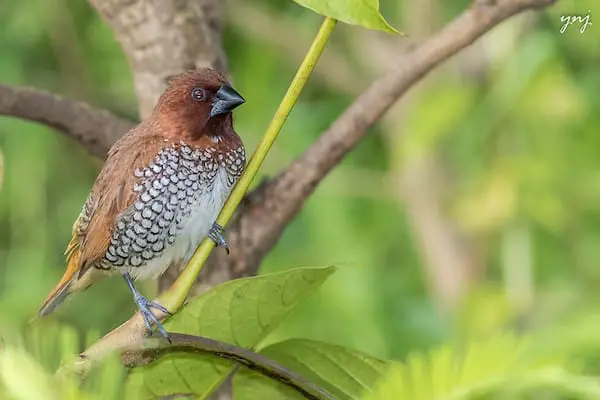
- Scientific name: Lonchura punctulata
- Other names: Nutmeg Mannikin, Spice Finch, Ricebirds
- Native: No
This species is native to India and southeast Asia. Once introduced to Hawaii in the late 1800’s, they spread pretty rapidly to most of the islands. The scaly-breasted munia has a warm brown back and head, thick black beak, and white underparts with a distinctive scaly pattern.
They feed on a variety of grass seeds, including rice, millet, and other cultivated grains. Because of this they are often found in agricultural areas. They are also attracted to bird feeders and will readily consume seeds that are provided for them, such as millet, sunflower seeds, and other small seeds.
In addition to seeds, scaly-breasted munias also feed on small insects and invertebrates, particularly during the breeding season when they need extra protein to raise their young. They are known to feed on ants, beetles, and other small insects that they find on the ground or in low vegetation.
30. Rock Pigeon
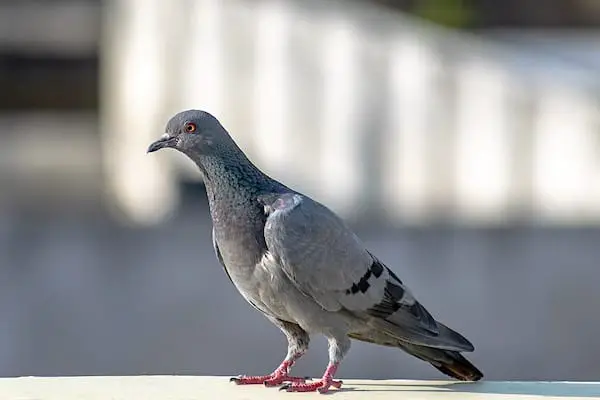
- Scientific name: Columba livia
- Other names: Rock Dove, Pigeon
- Native: No
Rock pigeons (often just called “pigeons”), are a common bird species found throughout the world. They have gray-blue plumage with two black bars on the wings, green-purple iridescence on the neck, and pink feet. Although, they can display a wide variety of different colors and patterns, including mostly white. They are not native to Hawaii (or the Americas for that matter), but are common on the islands. They may have been introduced as early as 1788.
ln Hawaii, rock pigeons are a common sight on rocky cliffs and in urban areas, including parks, plazas, and parking lots. They are often seen perched on buildings or foraging on the ground for food. This is one type of bird you seem to run into anywhere in the world you go, even on the remote islands of Hawaii!
31. Ruddy Turnstone
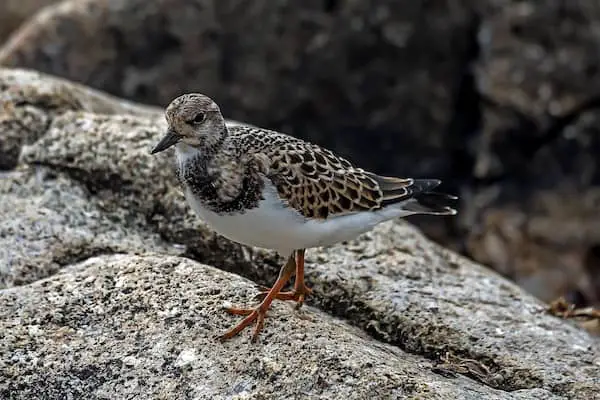
- Scientific name: Arenaria interpres
- Other names: ‘akekeke
- Native: Yes, Migratory
Ruddy turnstones are common shorebirds that breed in the Arctic regions of North America and Eurasia. They migrate to spend their winters in coastal regions of North and South America, as well as in the Caribbean and other tropical regions like Hawaii. These common winter visitors to the islands are called ‘akekeke.
When you see them in Hawaii, they will be in their non-breeding plumage. They have a pure white belly, orange legs, a brown and black mottled head and back, and a faint black band along the chest. They have short, pointed beaks that are ideal for foraging for small invertebrates and crustaceans, which make up the majority of their diet.
Find them in groups along beaches and rocky shoreline. While you probably won’t be able to notice from afar, their feet are a bit spiny with sharp nails that help them grip slippery wet rocks. Look for them especially in areas where seaweed, shells and other debris washes up and deposits along the shore.
32. Northern Cardinal

- Scientific name: Cardinalis cardinalis
- Other names: –
- Native: no
Native to North America, many American visitors may be surprised to see this cardinal in Hawaii. They were introduced to Hawaii in the early 1930s as part of an effort to introduce new bird species to the islands as a way to add more diversity to the bird population. Although that may not have been the best idea for the native bird species, these cardinals are generally well loved for their color and cheerful song.
Males are bright red with a black face mask, while the females have a more subdued brownish-red coloration. Both sexes have a distinctive crest on their head and a short, conical orange beak. Northern Cardinals are primarily seed-eating birds, but they also consume insects and small invertebrates.
They are attracted to bird feeders and will readily consume seeds that are provided for them. They have several variations of a melodious, whistling song. Males sing loudly from high perches, and are among the first birds you will hear in the morning. Northern Cardinals can be found throughout most of Oahu, and are often seen at resorts.
33. Saffron Finch
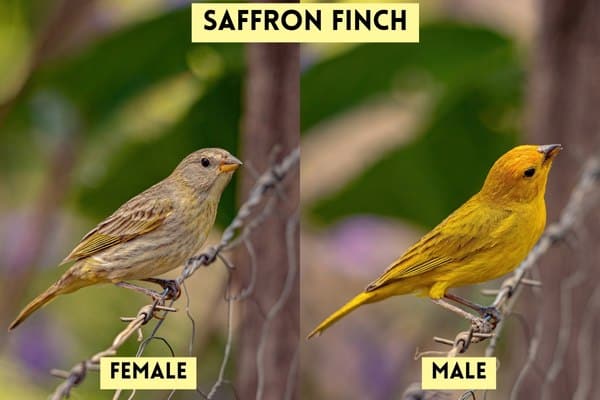
- Scientific name: Sicalis flaveola
- Other names: Pelzeln’s Finch
- Native: no
Saffron finches came to the Hawiian islands around 1965 and have expanded to most of the islands. The largest populations of these birds are found on the Big Island and O’ahu. These pretty birds are most often seen along the coasts on open lawns with short grass like resorts, parks and golf courses.
Saffron finches may look like canaries, but are members of the tanager family from South America. Males are bright yellow all over with hints of orange on his head. Females are dully and streaky with hints of yellow. Seeds and insects make up most of their diet.
